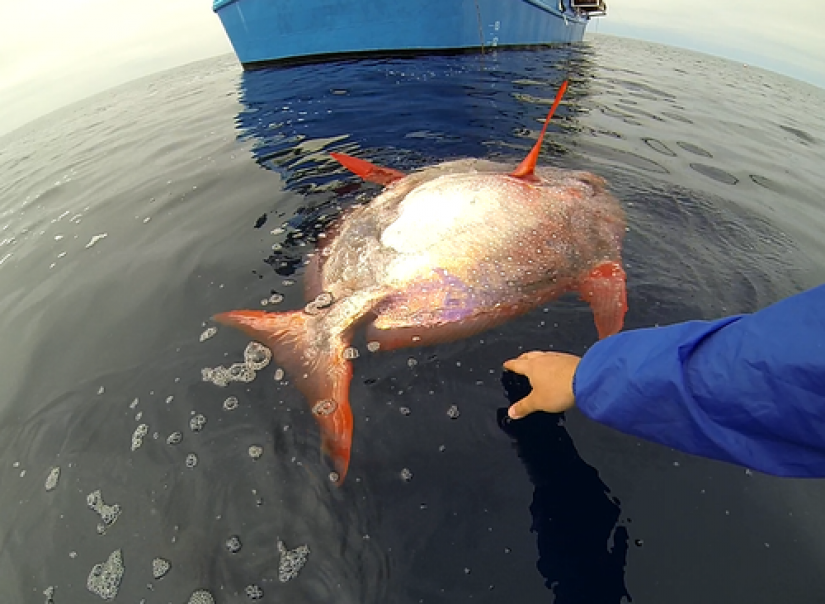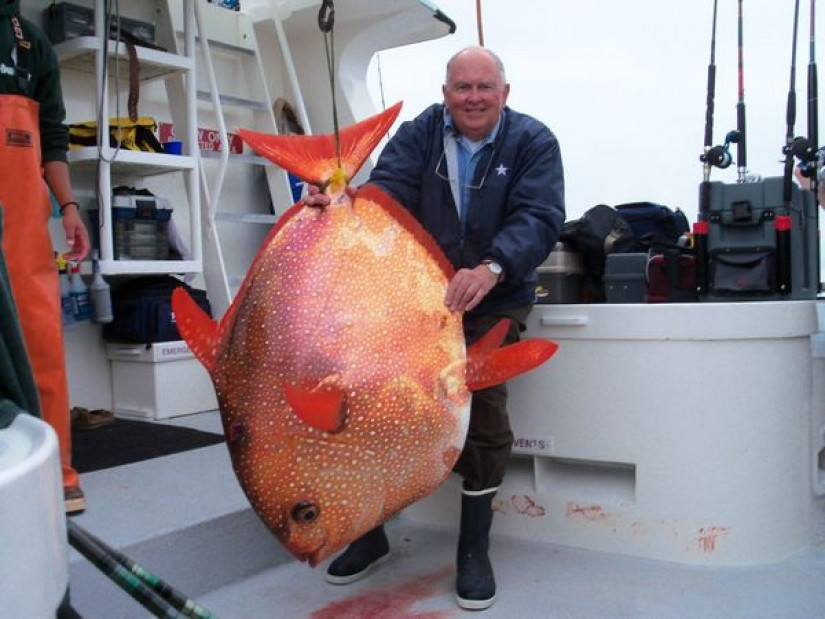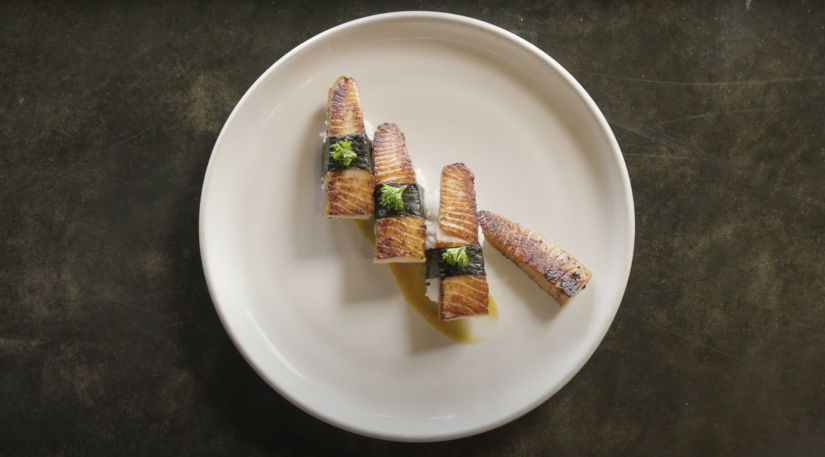Opah
Lampris guttatus
The Science
THE SCIENCE
Opah can warm its own blood by constantly flapping its fins, making it a fast-moving predator!

Taxonomic description
- Round, flat body that is silvery gray with pale red markings shading into orange-red fins and mouth
- Long pectoral and pelvic fins
- Can grow to an average of 3ft long and 100lbs [1]
Distribution
- Opah occur worldwide in temperate and tropical seas. Formerly believed to be two species (Lampris guttatus and L. immaculatus), recent genetic evidence reveals that there are actually 5 distinct lineages within Lampris guttatus, two of which occur in the North Pacific Ocean, smalleye Pacific opah (L. incognitus) and bigeye Pacific opah (L. megalopsis).
- Range of individual species is currently poorly understood. Smalleye opah are likely restricted to central and eastern North Pacific from at least Washington to well offshore south and east of Cabo San Lucas, Baja California and are the primary species observed in coastal waters. Bigeye opah are found at least from California to Chile and occur far offshore into the Central Pacific.[2]
- Pelagic, open ocean, generally in deep water, from the surface to depths in excess of 500 m (1,640 ft).[2]
life history
- Lifespan is unknown, although by using fin rays, scientists estimate that most opah taken in the pelagic longline fishery are between one and six years old. [2]
- Unlike other fish that primarily use their tail fin to swim in the water, opah rapidly flap their pectoral fins on the sides of their bodies to generate momentum. [4]
- Diet includes squid, epipelagic fish such as saury, mackerels, and anchovy, and deep-water fishes such as barracudinas. They are unique in that they can elevate the temperature of their whole body giving them an advantage as they forage in deep, cold water. [2]
Habitat
- Undergoes vertical migrations in the water column to feed on deeper prey and return to warmer, shallower waters to regulate body temperature. [4]
- Predators of adult opah likely include large sharks and some marine mammals. Juveniles are most likely eaten by sharks and other large predatory fish. [2]
- Challenges it faces in the environment- Unlike other fishes, the opah can conserve heat inside the gills, keeping their entire body core and head region significantly warmer than the surrounding environment, allowing its heart to pump faster and its muscles to perform more efficiently than other deep-sea fish. [4, 5]
- Deep-water habitats and sparse data availability makes it challenging to study, but is becoming an increasing priority for scientists. [6]
The Fishery
THE FISHERY
Opah are usually incidental catch in the swordfish and tuna fisheries, which are highly regulated in the U.S.

Seasonal availability
- Opah is available in California year-round, usually in ports where high-seas pelagic longline fisheries are making landings and selling their catch. [1,6]
Regulatory and managing authority
- Opah is managed under general finfish regulations from the California Department of Fish and Wildlife. [2]
- The commercial fisheries which catch opah are highly regulated by the Highly Migratory Species Fisheries Management Plan (HMS FMP), with gear restrictions, observer coverage, and time and area closures, depending on the gear type. [2]
gear type
- Currently, opah is a secondary target in some commercial fisheries, with most catch occurring in high-seas pelagic longline fisheries. In recent years, pelagic deep-set longline landings of opah have increased on the high-seas, as it is taken as a marketable secondary catch species when tuna fishing is unsuccessful or closed due to management restrictions. This increase in landings may be due to an increase in catch, a higher retention rate of caught opah as the market has developed, or both.[2]
- Recreational catch of opah is sporadic and mostly incidental to catch of other species, such as tunas on long-range fishing trips. [2,3]
status of the fishery
- Populations have never been formally assessed, but are presumed stable. [2,3]
- Collection of biological samples from opah began in 2009, followed by an electronic tagging program in 2011. This research will provide the basic life history information necessary for future population assessments and management. [3]
Potential ecosystem impacts
- Minimal impacts to habitat, as gear used to catch opah rarely contacts the seafloor. [3]
The Seafood
THE SEAFOOD
Opah's rich, creamy taste is similar to a cross between a tuna and a swordfish.

Edible portions
- Anatomically distinct from other fish. With many unusual cuts, breakdown requires some care to get full yield from a whole fish. [6]
- Unique heat distribution system creates seven different types of meat, each with a unique flavor and texture profile. [6]
Description of meat
- Opah has a firm texture and a rich, meaty flavor that is often likened to a cross between swordfish and tuna. It is mildly sweet with a buttery finish, making it versatile for various cooking methods.
- Gets its firm, “meaty” texture with large flakes from the abductor muscles. [4]
Culinary uses
- Opah can be grilled, seared, baked, or even used in ceviche due to its firm texture and robust flavor. It holds up well in soups and stews and can also be smoked for a unique twist.
- To preserve its delicate flavor, avoid overcooking. It is best served medium-rare to medium to maintain its juicy texture and full flavor.
- Grilled Opah steaks with a citrus salsa: OC Seafoods
- Opah corned beef hash: Fishful Future
Nutritional information
- Serving size: 4 oz. fresh (113g) [7]
- Opah is a nutritious seafood choice, rich in protein, omega-3 fatty acids, and various vitamins and minerals essential for health. It is low in saturated fats and calories, making it a healthy option for those looking to maintain a balanced diet.
Seasonal availability
- Opah is available year-round.
References
[1] Oregon Department of Fish and Wildlife. 2022. Fishing species, Opah. Web. https://myodfw.com/fishing/species/opah Date accessed: 14 September 2022.
[2] California Department of Fish and Wildlife. 2022. Species-at-a-glance, Opah. Web. https://marinespecies.wildlife.ca.gov/opah/false/ Date accessed: 12 December 2022.
[3] NOAA Fisheries. 2022. Species Directory, Opah. Web. https://www.fisheries.noaa.gov/species/opah#overview Date accessed: 12 December 2022.
[4] Wegner, N.C., Snodgrass, O.E., Dewar, H. and Hyde, J.R., 2015. Whole-body endothermy in a mesopelagic fish, the opah, Lampris guttatus. Science, 348(6236), pp.786-789. Date accessed: 9 July 2024.
[5] Britannica, The Editors of Encyclopaedia. 2021. "Opah". Encyclopedia Britannica, https://www.britannica.com/animal/opah-fish-genus. Date accessed: 9 July 2024.
[6] Cooper, R. 2019. “Characterizing patterns of opah (Lampris spp.) catch-per-unit-effort in the eastern North Pacific Ocean.” Escholarship.org. Date accessed: 9 July 2024.
[7] Hawaii Seafood Council. 2012. Moonfish (Lampris regius). https://manoa.hawaii.edu/ctahr/pacificfoodguide/index.php/chosen-from-t…. Date accessed: 9 July 2024.



